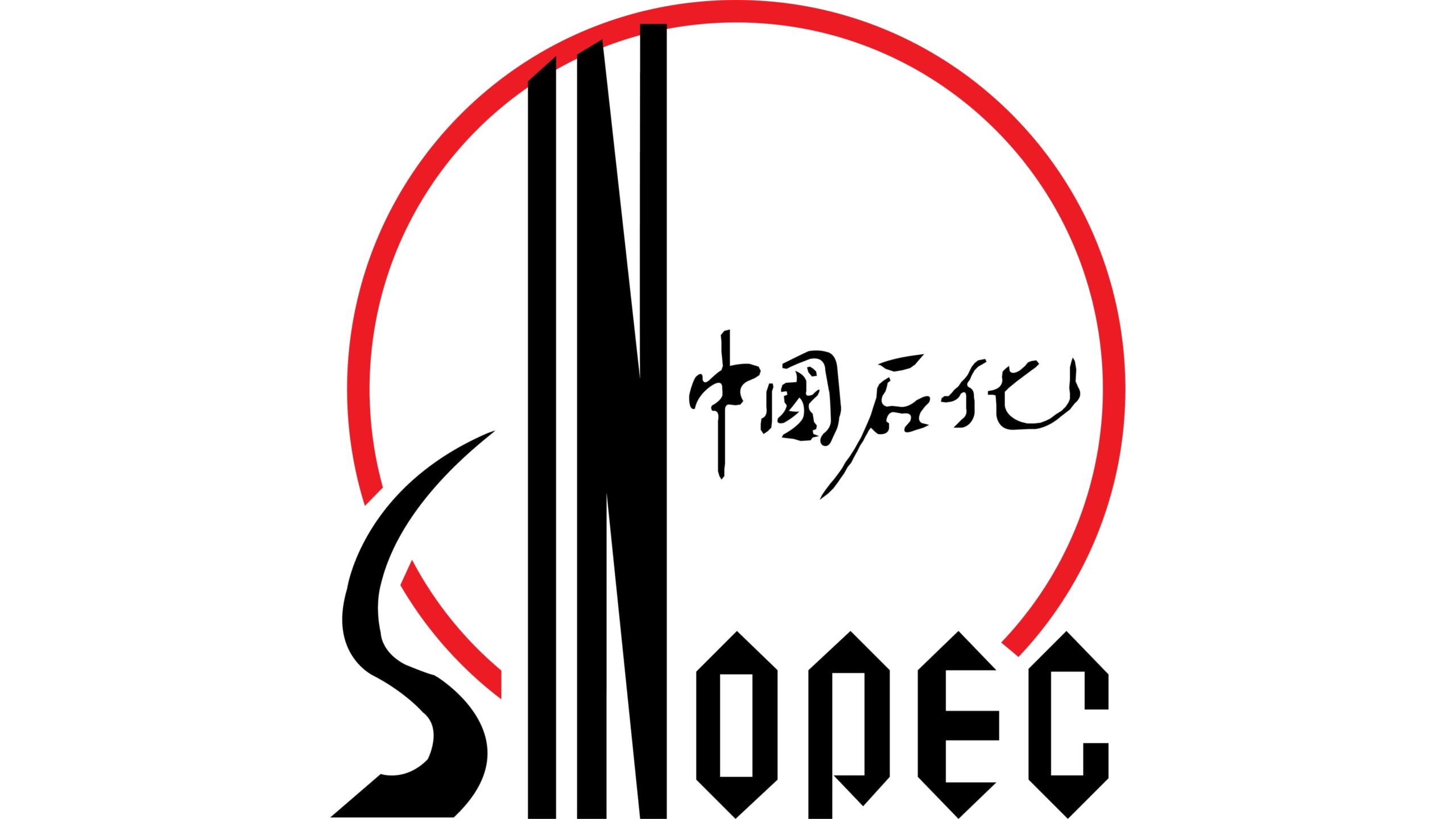Global Meta-Xylene Market By Application, By Distribution Channel, By End Use Industry, By Region & Segmental Insights Trends and Forecast, 2024 – 2034
- Industry: Chemicals & Materials
- Report ID: TNR-110-1241
- Number of Pages: 420
- Table/Charts : Yes
- August, 2024
- Base Year : 2024
- No. of Companies : 10+
- No. of Countries : 29
- Views : 10228
- Covid Impact Covered: Yes
- War Impact Covered: Yes
- Formats : PDF, Excel, PPT
The global meta-xylene market is experiencing robust growth driven by increasing demand for isophthalic acid, a key component in high-performance polyester resins and coatings. The expanding automotive and construction industries further propel market growth, particularly in emerging economies. Advancements in chemical manufacturing and the rising need for solvents in various industrial applications also contribute to the market’s expansion.
Key trends include a shift towards sustainable and eco-friendly chemicals, which opens opportunities for innovation in bio-based meta-xylene production. Additionally, strategic partnerships and mergers among key players are fostering market consolidation. However, stringent environmental regulations and fluctuating raw material prices present challenges that could impact market dynamics in the coming years. In terms of revenue, the global meta-xylene market was worth US$ 1.46 Bn in 2023, anticipated to witness a CAGR of 6.4% during 2024 – 2034.
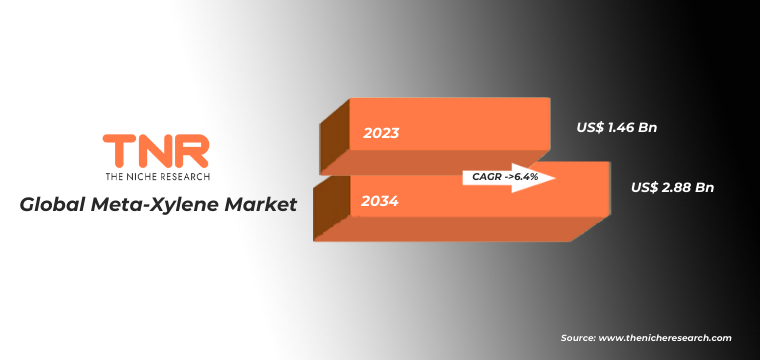
Global Meta-Xylene Market Segmental Analysis:
Meta-Xylene Market By Application
2,4- and 2,6-xylidine segment has rapidly emerged as the fastest-growing segment in the global meta-xylene market, driven by its critical role in the production of herbicides, dyes, and pharmaceutical intermediates. The increasing demand for agrochemicals, particularly herbicides, has significantly boosted the consumption of xylidine derivatives. Additionally, the growing pharmaceutical industry, especially in developing regions, has escalated the need for xylidines as key intermediates in drug synthesis. The segment’s growth is also supported by advancements in chemical manufacturing processes, enabling more efficient production. Furthermore, rising investments in research and development for specialized applications are expected to sustain this upward trend, making the 2,4- and 2,6-xylidine segment a focal point of the meta-xylene market.
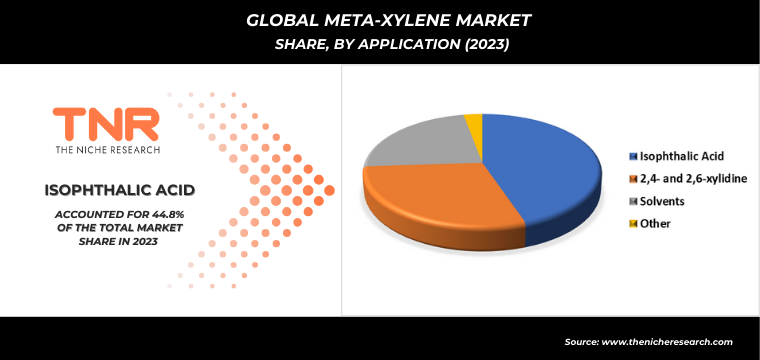
Meta-Xylene Market By Distribution Channel
In 2023, the direct segment dominated the global meta-xylene market, capturing a substantial revenue share of 78.7%. This dominance is attributed to the widespread use of meta-xylene in producing isophthalic acid, a crucial component in high-performance polyester resins and coatings. The direct segment’s growth is further fueled by its application in the automotive, construction, and packaging industries, where demand for durable and efficient materials is rising. Additionally, the segment benefits from streamlined supply chains and increased investments in production capacity, solidifying its leading position in the global market.
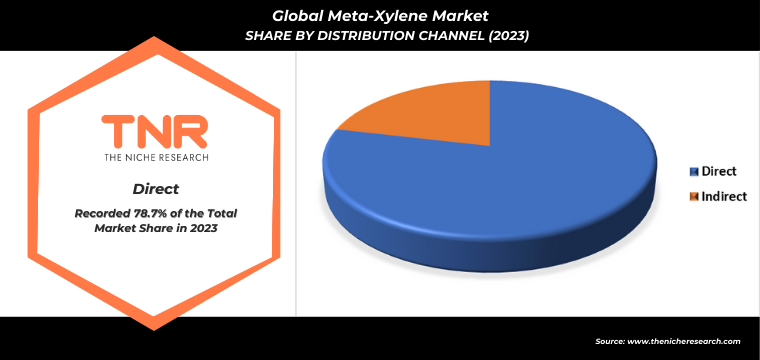
Meta-Xylene Market By End Use Industry
Construction emerged as the dominant segment in the global meta-xylene market in 2023, capturing a significant revenue share of 25.2%. This strong performance is driven by the increasing demand for high-performance materials, particularly polyester resins and coatings, which are essential in the construction industry for their durability and resistance to environmental factors. The segment’s growth is also supported by expanding infrastructure projects in emerging economies, where meta-xylene-based products are widely used in paints, adhesives, and sealants. Additionally, the trend towards sustainable construction practices is boosting the adoption of meta-xylene derivatives, which are integral to producing eco-friendly and energy-efficient building materials. This positions the construction segment as a key driver of market expansion.

Meta-Xylene Market By Region
Middle East & Africa is projected to be the fastest-growing region in the meta-xylene market during the forecast period, driven by rapid industrialization and expanding infrastructure development. The region’s increasing investment in petrochemical facilities, coupled with growing construction activities, is boosting the demand for meta-xylene, particularly in the production of coatings, resins, and adhesives. Additionally, the rising focus on diversifying economies away from oil dependency is spurring growth in various manufacturing sectors, further fueling meta-xylene consumption. Government initiatives aimed at enhancing industrial capabilities and attracting foreign investments are also contributing to the region’s accelerated market expansion, making it a key area of growth in the global meta-xylene landscape.
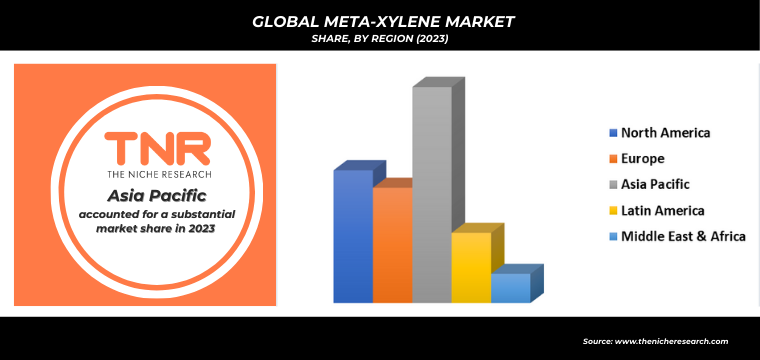
Global Meta-Xylene Market Dynamics
Global Meta-Xylene Market Growth Driver:
The global meta-xylene market is driven by the rising demand for isophthalic acid, a key intermediate in producing high-performance polyester resins and coatings. The automotive and construction industries, particularly in emerging markets, are significant consumers, fueling demand for meta-xylene. Additionally, the growth of the chemical industry, coupled with increasing use of solvents in industrial applications, further supports market expansion. Technological advancements and innovations in production processes enhance efficiency and scalability, making meta-xylene more accessible. The push towards sustainable and eco-friendly chemicals also opens up new avenues for market growth as industries seek alternatives to traditional raw materials.
Global Meta-Xylene Market Restraint:
The global meta-xylene market faces several restraints, including stringent environmental regulations that limit the production and use of volatile organic compounds (VOCs) like xylene. These regulations increase compliance costs and may lead to the development of alternatives, reducing demand for meta-xylene. Additionally, the market is vulnerable to fluctuations in crude oil prices, as xylene is derived from petroleum. These price volatilities can impact the cost structure and profitability of manufacturers. Moreover, the market faces competition from bio-based chemicals, which are gaining traction due to growing environmental concerns, further challenging the growth potential of meta-xylene.
Global Meta-Xylene Market Opportunity:
The global meta-xylene market presents significant opportunities driven by the increasing adoption of sustainable and eco-friendly chemicals. As industries shift towards greener solutions, the development of bio-based meta-xylene and other environmentally friendly derivatives can open new growth avenues. Additionally, the expansion of infrastructure and construction projects in emerging economies, particularly in Asia-Pacific and the Middle East & Africa, offers considerable market potential. The rising demand for high-performance materials in automotive and aerospace industries also creates opportunities for meta-xylene applications. Furthermore, investments in research and development aimed at improving production efficiency and product innovation can help companies gain a competitive edge.
Global Meta-Xylene Market Trend:
Key trends in the global meta-xylene market include a growing emphasis on sustainability and the development of bio-based alternatives. The shift towards environmentally friendly chemicals is reshaping the market, with increased research into green production methods. Additionally, the market is witnessing consolidation, with mergers, acquisitions, and strategic partnerships becoming more common as companies seek to expand their market share and global reach. The rise of digitalization and advanced manufacturing technologies is also influencing the industry, enhancing production efficiency and reducing costs. Furthermore, there is a notable trend towards regional diversification, with emerging markets playing a more prominent role in the global meta-xylene landscape.
Competitive Landscape
The global meta-xylene market’s competitive landscape is characterized by the presence of major chemical manufacturers focusing on strategic mergers, acquisitions, and partnerships to expand their market share. Companies are investing in research and development to innovate sustainable production methods and enhance product offerings, while also expanding their geographical reach to tap into emerging markets.
Some of the players operating in the meta-xylene market are
- Avantor
- Compania Espanola De Petroleos, S.A.U. (Cepsa)
- Exxonmobil
- GS Caltex Corporation
- Honeywell International Inc.
- Lotte Chemical
- Merck KGaA
- MITSUBISHI GAS CHEMICAL COMPANY INC.
- Parchem fine & specialty chemicals
- Shell Chemicals LTD
- TCI Chemicals (India) Pvt. Ltd.
- Thermo Fisher Scientific Inc
- Other Industry Participants
Global Meta-Xylene Market Scope
| Report Specifications | Details |
| Market Revenue in 2023 | US$ 1.46 Bn |
| Market Size Forecast by 2034 | US$ 2.88 Bn |
| Growth Rate (CAGR) | 6.4% |
| Historic Data | 2016 – 2022 |
| Base Year for Estimation | 2023 |
| Forecast Period | 2024 – 2034 |
| Report Inclusions | Market Size & Estimates, Market Dynamics, Competitive Scenario, Trends, Growth Factors, Market Determinants, Key Investment Segmentation, Product/Service/Solutions Benchmarking |
| Segments Covered | By Application, By Distribution Channel, By End Use Industry, By Region |
| Regions Covered | North America, Europe, Asia Pacific, Middle East & Africa, Latin America |
| Countries Covered | U.S., Canada, Mexico, Rest of North America, France, The UK, Spain, Germany, Italy, Nordic Countries (Denmark, Finland, Iceland, Sweden, Norway), Benelux Union (Belgium, The Netherlands, Luxembourg), Rest of Europe, China, Japan, India, New Zealand, Australia, South Korea, Southeast Asia (Indonesia, Thailand, Malaysia, Singapore, Rest of Southeast Asia), Rest of Asia Pacific, Saudi Arabia, UAE, Egypt, Kuwait, South Africa, Rest of Middle East & Africa, Brazil, Argentina, Rest of Latin America |
| Key Players | Avantor, Compania Espanola De Petroleos, S.A.U. (Cepsa), Exxonmobil, GS Caltex Corporation, Honeywell International Inc., Lotte Chemical, Merck KGaA, MITSUBISHI GAS CHEMICAL COMPANY INC., Parchem fine & specialty chemicals, Shell Chemicals LTD, TCI Chemicals (India) Pvt. Ltd., Thermo Fisher Scientific Inc |
| Customization Scope | Customization allows for the inclusion/modification of content pertaining to geographical regions, countries, and specific market segments. |
| Pricing & Procurement Options | Explore purchase options tailored to your specific research requirements |
| Contact Details | Consult With Our Expert
Japan (Toll-Free): +81 663-386-8111 South Korea (Toll-Free): +82-808- 703-126 Saudi Arabia (Toll-Free): +966 800-850-1643 United Kingdom: +44 753-710-5080 United States: +1 302-232-5106 E-mail: askanexpert@thenicheresearch.com
|
Global Meta-Xylene Market
By Application
- Isophthalic Acid
- 2,4- and 2,6-xylidine
- Solvents
- Other
By Distribution Channel
- Direct
- Indirect
By End Use Industry
- Automotive
- Construction
- Textiles
- Aerospace
- Packaging
- Others
By Region
- North America (U.S., Canada, Mexico, Rest of North America)
- Europe (France, The UK, Spain, Germany, Italy, Nordic Countries (Denmark, Finland, Iceland, Sweden, Norway), Benelux Union (Belgium, The Netherlands, Luxembourg), Rest of Europe)
- Asia Pacific (China, Japan, India, New Zealand, Australia, South Korea, Southeast Asia (Indonesia, Thailand, Malaysia, Singapore, Rest of Southeast Asia), Rest of Asia Pacific)
- Middle East & Africa (Saudi Arabia, UAE, Egypt, Kuwait, South Africa, Rest of Middle East & Africa)
- Latin America (Brazil, Argentina, Rest of Latin America)
Report Layout:
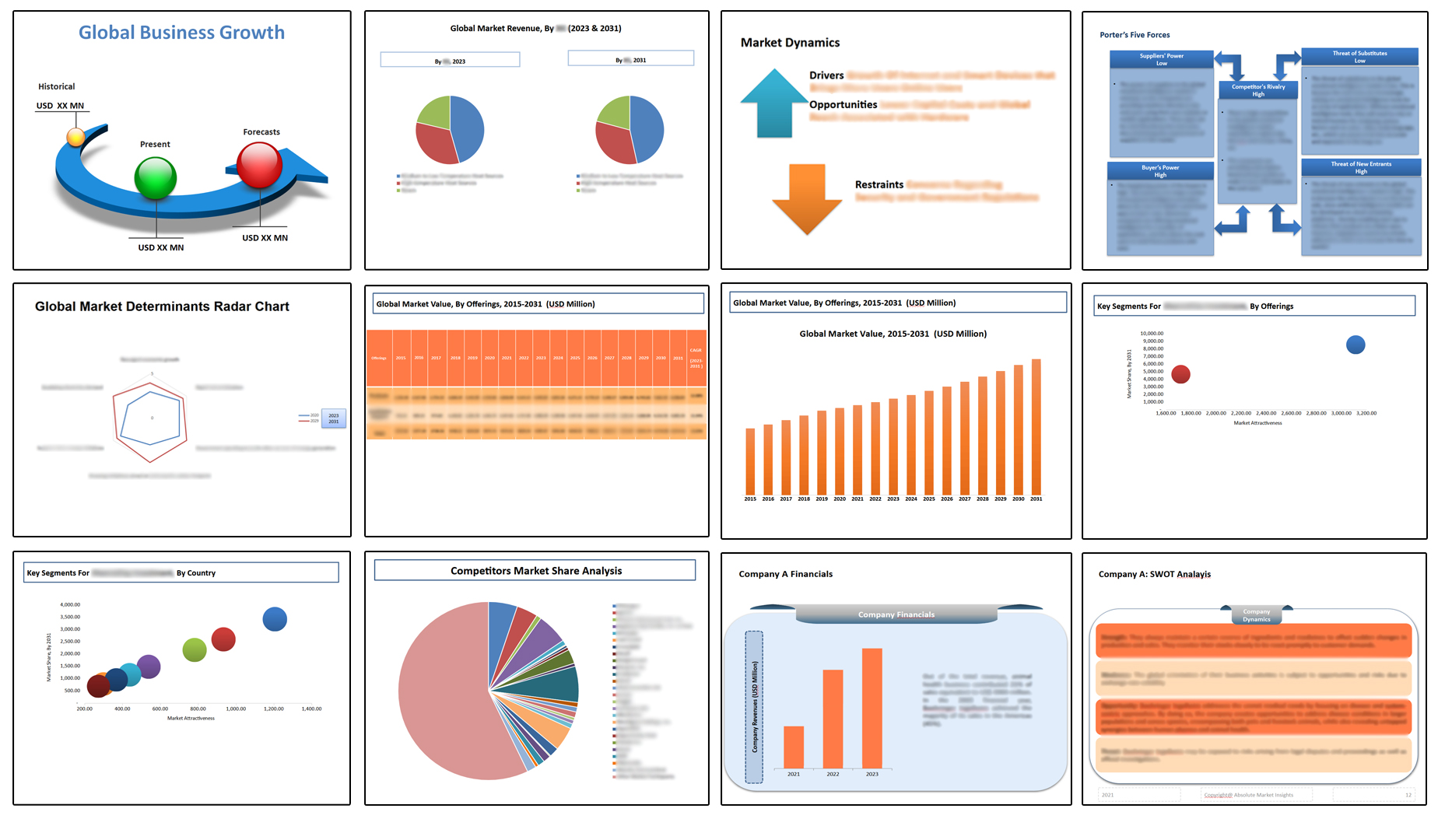
Table of Contents
Note: This ToC is tentative and can be changed according to the research study conducted during the course of report completion.
**Exclusive for Multi-User and Enterprise User.
Global Meta-Xylene Market
By Application
- Isophthalic Acid
- 2,4- and 2,6-xylidine
- Solvents
- Other
By Distribution Channel
- Direct
- Indirect
By End Use Industry
- Automotive
- Construction
- Textiles
- Aerospace
- Packaging
- Others
By Region
- North America (U.S., Canada, Mexico, Rest of North America)
- Europe (France, The UK, Spain, Germany, Italy, Nordic Countries (Denmark, Finland, Iceland, Sweden, Norway), Benelux Union (Belgium, The Netherlands, Luxembourg), Rest of Europe)
- Asia Pacific (China, Japan, India, New Zealand, Australia, South Korea, Southeast Asia (Indonesia, Thailand, Malaysia, Singapore, Rest of Southeast Asia), Rest of Asia Pacific)
- Middle East & Africa (Saudi Arabia, UAE, Egypt, Kuwait, South Africa, Rest of Middle East & Africa)
- Latin America (Brazil, Argentina, Rest of Latin America)
The Niche Research approach encompasses both primary and secondary research methods to provide comprehensive insights. While primary research is the cornerstone of our studies, we also incorporate secondary research sources such as company annual reports, premium industry databases, press releases, industry journals, and white papers.
Within our primary research, we actively engage with various industry stakeholders, conducting paid interviews and surveys. Our meticulous analysis extends to every market participant in major countries, allowing us to thoroughly examine their portfolios, calculate market shares, and segment revenues.
Our data collection primarily focuses on individual countries within our research scope, enabling us to estimate regional market sizes. Typically, we employ a bottom-up approach, meticulously tracking trends in different countries. We analyze growth drivers, constraints, technological innovations, and opportunities for each country, ultimately arriving at regional figures.Our process begins by examining the growth prospects of each country. Building upon these insights, we project growth and trends for the entire region. Finally, we utilize our proprietary model to refine estimations and forecasts.
Our data validation standards are integral to ensuring the reliability and accuracy of our research findings. Here’s a breakdown of our data validation processes and the stakeholders we engage with during our primary research:
- Supply Side Analysis: We initiate a supply side analysis by directly contacting market participants, through telephonic interviews and questionnaires containing both open-ended and close-ended questions. We gather information on their portfolios, segment revenues, developments, and growth strategies.
- Demand Side Analysis: To gain insights into adoption trends and consumer preferences, we reach out to target customers and users (non-vendors). This information forms a vital part of the qualitative analysis section of our reports, covering market dynamics, adoption trends, consumer behavior, spending patterns, and other related aspects.
- Consultant Insights: We tap into the expertise of our partner consultants from around the world to obtain their unique viewpoints and perspectives. Their insights contribute to a well-rounded understanding of the markets under investigation.
- In-House Validation: To ensure data accuracy and reliability, we conduct cross-validation of data points and information through our in-house team of consultants and utilize advanced data modeling tools for thorough verification.
The forecasts we provide are based on a comprehensive assessment of various factors, including:
- Market Trends and Past Performance (Last Five Years): We accurately analyze market trends and performance data from preceding five years to identify historical patterns and understand the market’s evolution.
- Historical Performance and Growth of Market Participants: We assess the historical performance and growth trajectories of key market participants. This analysis provides insights into the competitive landscape and individual company strategies.
- Market Determinants Impact Analysis (Next Eight Years): We conduct a rigorous analysis of the factors that are projected to influence the market over the next eight years. This includes assessing both internal and external determinants that can shape market dynamics.
- Drivers and Challenges for the Forecast Period:Identify the factors expected to drive market growth during the forecast period, as well as the challenges that the industry may face. This analysis aids in deriving an accurate growth rate projection.
- New Acquisitions, Collaborations, or Partnerships: We keep a close watch on any new acquisitions, collaborations, or partnerships within the industry. These developments can have a significant impact on market dynamics and competitiveness.
- Macro and Micro Factors Analysis:A thorough examination of both macro-level factors (e.g., economic trends, regulatory changes) and micro-level factors (e.g., technological advancements, consumer preferences) that may influence the market during the forecast period.
- End-User Sentiment Analysis: To understand the market from the end-user perspective, we conduct sentiment analysis. This involves assessing the sentiment, preferences, and feedback of the end-users, which can provide valuable insights into market trends.
- Perspective of Primary Participants: Insights gathered directly from primary research participants play a crucial role in shaping our forecasts. Their perspectives and experiences provide valuable qualitative data.
- Year-on-Year Growth Trend: We utilize a year-on-year growth trend based on historical market growth and expected future trends. This helps in formulating our growth projections, aligning them with the market’s historical performance.
Research process adopted by TNR involves multiple stages, including data collection, validation, quality checks, and presentation. It’s crucial that the data and information we provide add value to your existing market understanding and expertise. We have also established partnerships with business consulting, research, and survey organizations across regions and globally to collaborate on regional analysis and data validation, ensuring the highest level of accuracy and reliability in our reports.


